5 ข้อเท็จจริงเกี่ยวกับการปลูกผมแบบไม่ผ่าตัด โดยคุณหมอปิยะ

ยินดีต้อนรับสู่ Behind Cosmetic Surgery By Dr. Piya ที่จะพาคุณสำรวจโลกที่น่าหลงใหลของความงาม พร้อมตอบคำถามที่คุณสงสัยทั้งหมดด้วยคำแนะนำจากผู้เชี่ยวชาญที่ได้รับการยอมรับอย่างสูง นั่นก็คือ นพ. ปิยะ รังรักษ์ศิริ หรือที่รู้จักกันในชื่อ "คุณหมอปิยะ" ผู้ซึ่งไม่เพียงเป็นชื่อที่ได้รับการยอมรับในวงการศัลยกรรมความงาม แต่ยังเป็นศัลยแพทย์ตกแต่งที่ได้รับการรับรองจากสมาคมศัลยแพทย์ตกแต่งเสริมสวยนานาชาติ (ISAPS) และสมาคมศัลยแพทย์ตกแต่งแห่งอเมริกา (ASPS)
นพ. ปิยะ รังรักษ์ศิริ ดำรงตำแหน่ง CEO และศัลยแพทย์ตกแต่งที่ปรึกษาที่ Nida Esth’ International ศูนย์การแพทย์ด้านความงามชั้นนำในกรุงเทพฯ คลินิกนี้มีชื่อเสียงด้านการรักษาและเทคโนโลยีที่ล้ำสมัย รวมถึงการดูแลคนไข้อย่างยอดเยี่ยม ในปี 2023 ได้รับรางวัล 'คลินิกปลูกผมแบบไม่ผ่าตัดที่มีนวัตกรรมมากที่สุดในภูมิภาคเอเชียแปซิฟิก' จาก Global Health Asia Pacific รางวัลนี้สะท้อนถึงความมุ่งมั่นของคลินิกในการขยายขอบเขตของการฟื้นฟูเส้นผมแบบไม่ผ่าตัด ทำให้เป็นจุดหมายปลายทางด้านความงามอันดับหนึ่งสำหรับคนดัง ผู้นำระดับชาติ และบุคคลชั้นสูงที่แสวงหาความก้าวหน้าล่าสุดในด้านความงาม

ในฐานะศัลยแพทย์ตกแต่งที่มุ่งมั่นในการคืนความมั่นใจและรูปลักษณ์ให้กับคนไข้ การเดินทางในเส้นทางการรักษาผมร่วงของผมเป็นการผสมผสานระหว่างการค้นคว้าและนวัตกรรมอย่างต่อเนื่อง ตลอดหลายปีที่ผ่านมา ผมได้พบกับคนจำนวนมากที่มองหาวิธีการรักษาที่มีประสิทธิภาพโดยไม่ต้องพึ่งการผ่าตัดแบบดั้งเดิม นี่เป็นแรงผลักดันให้ผมได้นำวิธีการฟื้นฟูเส้นผมแบบไม่ผ่าตัดที่ทันสมัยที่สุดมาใช้ในคลินิกของผม
ในบทความนี้ ผมจะพาคุณไปรู้จักกับแนวคิดหลักที่เป็นแรงผลักดันให้เกิดการรักษาอันล้ำสมัยเหล่านี้ เราจะสำรวจ UR Cell Hair Micro Transplant+ ซึ่งใช้เซลล์ต้นกำเนิดในการฟื้นฟูรูขุมขนในระดับพื้นฐานที่สุดโดยใช้พลังการฟื้นฟูของเซลล์ต้นกำเนิด นอกจากนี้ เรายังจะพูดถึง Fotona HAIRestart เทคโนโลยีเลเซอร์ล้ำสมัยที่ใช้พลังงานเลเซอร์อย่างแม่นยำในการกระตุ้นการเจริญเติบโตของเส้นผมตามธรรมชาติและเสริมสุขภาพของหนังศีรษะ สุดท้าย เราจะวิเคราะห์ HARG Therapy การบำบัดด้วยสารกระตุ้นการเจริญเติบโตที่ใช้โมเลกุลชีวภาพที่ทรงพลังซึ่งมีบทบาทสำคัญในกระบวนการฟื้นฟูเส้นผม
เทคนิคแต่ละวิธีเหล่านี้ถือเป็นก้าวสำคัญในด้านการฟื้นฟูเส้นผมแบบไม่ผ่าตัด ช่วยให้คนไข้มีโอกาสกลับมามีเส้นผมและความมั่นใจอีกครั้ง ด้วยระยะเวลาพักฟื้นที่น้อยที่สุดและผลลัพธ์ที่ยอดเยี่ยมที่สุด เมื่อคุณเข้าใจแนวคิดสำคัญเหล่านี้ คุณจะสามารถตัดสินใจได้อย่างมีข้อมูลเกี่ยวกับวิธีการที่เหมาะสมที่สุดสำหรับสถานการณ์เฉพาะของคุณ
1. การปลูกผมแบบไม่ผ่าตัดคืออะไร?
การปลูกผมแบบไม่ผ่าตัดเป็นวิธีการที่ล้ำสมัยที่ออกแบบมาเพื่อฟื้นฟูเส้นผมโดยการกระตุ้นกระบวนการเจริญเติบโตของเส้นผมตามธรรมชาติของหนังศีรษะ โดยไม่ต้องอาศัยการผ่าตัดหรือการปลูกถ่ายเส้นผม วิธีการเหล่านี้อิงจากหลักการทางวิทยาศาสตร์ขั้นสูงที่ใช้ความสามารถในการฟื้นฟูตามธรรมชาติของร่างกาย ต่อไปนี้คือสามเทคนิคหลักของการปลูกผมแบบไม่ผ่าตัด
1.1 Stem Cell Concept: UR Cell Hair Micro Transplant+
UR Cell Hair MicroTransplant+ เป็น เทคนิคปลูกผมแบบไม่ผ่าตัด ที่ได้รับการจดสิทธิบัตรและพัฒนาโดยทีมแพทย์ผู้เชี่ยวชาญด้านศัลยกรรมตกแต่งและโรคผิวหนังจาก Nida Esth’ โดยอิงตาม ทฤษฎีเซลล์ต้นกำเนิด (Stem Cell Theory)การวิจัยและพัฒนาใช้เวลากว่า 8-9 ปี เพื่อหาวิธีแก้ปัญหาสำหรับคนไข้ที่ประสบปัญหา ผมร่วงจากฮอร์โมนหรือกรรมพันธุ์ (Androgenetic Alopecia หรือ AGA) โดยเฉพาะผู้ที่ไม่ต้องการเข้ารับการผ่าตัดหรือรับประทานยาที่ยับยั้งฮอร์โมนเพศชาย เนื่องจากกังวลผลข้างเคียงที่อาจส่งผลต่อสมรรถภาพทางเพศและระบบสืบพันธุ์
ด้วยความเชี่ยวชาญและประสบการณ์ของทีมแพทย์ รวมถึงความสำเร็จจากการรักษาคนไข้นับพันราย เราได้พัฒนา เทคนิคการปลูกผมแบบไม่ผ่าตัด ที่ไม่เคยมีมาก่อน โดยใช้วิธีฝัง เซลล์ต้นกำเนิด จากยุโรปที่ช่วยเพิ่มความหนาแน่นของรูขุมขนอย่างมีประสิทธิภาพ ผสานกับ HARG Therapy (Hair Regenerative Therapy) ซึ่งเป็นเทคนิคเฉพาะจากญี่ปุ่นที่ช่วยเพิ่มความหนาของรูขุมขน เทคนิคนี้ได้รับการพิสูจน์แล้วว่าประสบความสำเร็จ โดยมีคนไข้จากหลากหลายประเทศเดินทางมายังกรุงเทพฯ เพื่อเข้ารับ การปลูกผมถาวร นี้ที่ Nida Esth’

จากประสบการณ์กว่า 8-9 ปี และการรักษาคนไข้มากกว่า 1,000 ราย เราภูมิใจนำเสนอ เทคนิคการปลูกผม ที่ช่วยแก้ปัญหา ผมบาง และ ผมร่วง ได้อย่างปลอดภัยและมีประสิทธิภาพสูงสุด UR Cell Hair MicroTransplant+ แสดงผลลัพธ์ที่น่าพึงพอใจในกรณีดังต่อไปนี้:
- คนไข้ที่มีปัญหาผมร่วงจากฮอร์โมนและกรรมพันธุ์ (AGA):
โดยเฉพาะในระยะเริ่มต้นถึงปานกลาง ซึ่งยังคงมีรูขุมขนที่มีชีวิตอยู่ในบริเวณที่ต้องการรับการรักษา - ประสบความสำเร็จทั้งในผู้ชายและผู้หญิง:
เทคนิคนี้เหมาะสำหรับทั้งสองเพศ และได้รับการพิสูจน์แล้วว่ามีประสิทธิภาพ - การรักษาแสดงผลลัพธ์ที่ดีในคนไข้จากหลากหลายเชื้อชาติ:
เทคนิคนี้ได้รับความไว้วางใจจากคนไข้ทั่วโลก - เพิ่มความหนาของเส้นผมในผู้ที่เคยปลูกผมมาก่อน:
ในกรณีที่คนไข้เคยเข้ารับการปลูกผมแบบดั้งเดิม เช่น FUE หรือ FUT เทคนิคนี้ช่วยเพิ่มความหนาของเส้นผมได้อย่างมีประสิทธิภาพ
เทคนิค UR Cell Hair Micro Transplant+ จึงเป็นทางเลือกที่เหมาะสำหรับผู้ที่ต้องการ ฟื้นฟูเส้นผมแบบไม่ผ่าตัด พร้อมผลลัพธ์ที่ปลอดภัยและมีประสิทธิภาพสูง การรักษานี้เหมาะสำหรับผู้ที่ต้องการแก้ปัญหา ผมบาง และ ผมร่วงเรื้อรัง ในลักษณะต่างๆ
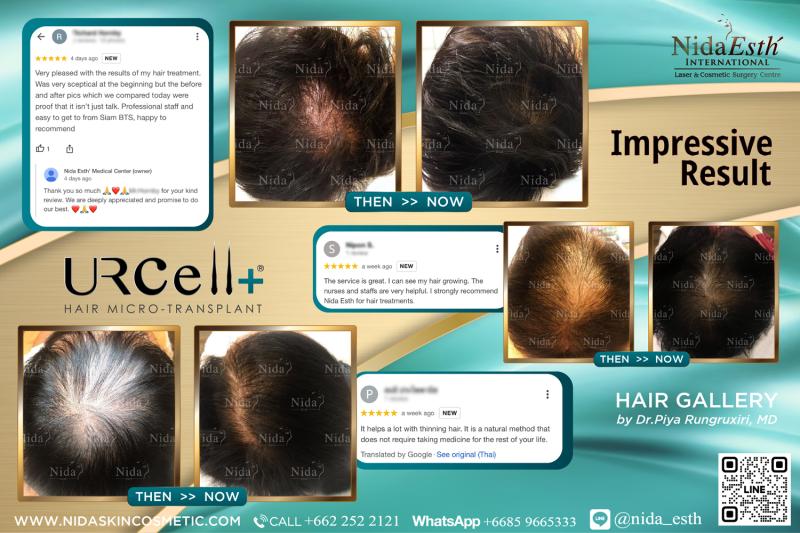
ขั้นตอนการรักษา UR Cell Hair MicroTransplant+
เพื่อความปลอดภัยและตอบสนองความต้องการของคนไข้ ทีมแพทย์ของเราได้วางแผนการรักษาออกเป็น 3 ระยะ ในช่วงระยะเวลา 3-6 เดือน ซึ่งอาจปรับเปลี่ยนตามการพิจารณาของแพทย์ โดยพิจารณาจากปัจจัยต่างๆ เช่น ความรุนแรงของปัญหาและสุขภาพของรูขุมขน การรักษานี้ได้รับการยอมรับในฐานะหนึ่งใน วิธีการปลูกผมแบบไม่ผ่าตัด ที่ล้ำสมัยที่สุด ช่วยฟื้นฟูและเสริมสร้างความมั่นใจให้คนไข้ด้วยเส้นผมที่แข็งแรงและดูเป็นธรรมชาติ
1. ก่อนการปลูกผมด้วยเซลล์ (Pre-Micro Transplant)
- สแกนและวิเคราะห์เซลล์รูขุมขน ด้วยระบบ Nano Score Robotic System
- ตรวจ Oxidative Stress Test เพื่อตรวจหาสารอนุมูลอิสระในเลือดที่อาจทำให้เซลล์รูขุมขนเสื่อม
- ปรึกษาส่วนตัวกับศัลยแพทย์ผู้รักษา
- ออกแบบแผนการรักษา Individual Micro Transplant โดยใช้ระบบ AI
2. ระหว่างการปลูกผมด้วยเซลล์ (Micro Transplant)
- การปลูกเซลล์รูขุมขน โดย พ.ต.ท. นพ. ปิยะ รังรักษ์ศิริ
- การบำบัดด้วย Low-Level Laser Therapy (LLLT): ใช้เลเซอร์พลังงานต่ำเพื่อเร่งปฏิกิริยาการแบ่งเซลล์
3. หลังการปลูกผมด้วยเซลล์ (Post-Micro Transplant)
- การบ่มเซลล์รูขุมขน เพื่อให้เซลล์ที่ปลูกใหม่เจริญเติบโตอย่างมีประสิทธิภาพ
- การบำบัด Hair Regenerative Therapy (HARG)
- การปรับสมดุลฮอร์โมนผม Hair Hormone เพื่อช่วยปรับสมดุลของเซลล์
- การดูแลเรื่องสารอาหารสำหรับเส้นผม Hair Nutrition
- การบำบัดด้วยเลเซอร์พลังงานต่ำ Low-Level Laser Therapy (LLLT) เพื่อเร่งการแบ่งเซลล์
- สแกนและวิเคราะห์ผลการรักษา ด้วย Nano Score Robotic System เพื่อเปรียบเทียบผลลัพธ์
- การใช้ สมุนไพรญี่ปุ่น เป็นโปรแกรมดูแลที่บ้าน เพื่อลดผลกระทบจากฮอร์โมนเพศชายบริเวณรูขุมขน และส่งเสริมการแบ่งเซลล์ต้นกำเนิดที่ฝังในรูขุมขน
UR Cell Hair MicroTransplant+ ได้รับการออกแบบมาเพื่อมอบผลลัพธ์ที่ยั่งยืน พร้อมตอบโจทย์ความต้องการของคนไข้ในทุกมิติ ทั้งด้านความปลอดภัย ประสิทธิภาพ และการฟื้นฟูเส้นผมในระยะยาว

ผู้ที่เหมาะสมสำหรับการรักษา
- ผมร่วงจากกรรมพันธุ์และฮอร์โมน: เหมาะสำหรับผู้ที่มีปัญหาผมร่วงในระดับเริ่มต้นถึงปานกลาง (Mild to Moderate Degree)
- ผู้ที่เคยผ่าตัดปลูกผมมาก่อน: สำหรับผู้ที่เคยเข้ารับการปลูกผมแล้วแต่ผลลัพธ์ยังไม่เป็นที่พอใจ และต้องการเพิ่มความหนาแน่นและความหนาของเส้นผมเพิ่มเติม
ข้อดีของการรักษา
- ไม่ต้องทานยา ไม่ต้องผ่าตัด: ไม่มีผลกระทบต่อระบบสืบพันธุ์และไม่มีผลข้างเคียงต่อสมรรถภาพทางเพศ
- เพิ่มความหนาแน่นและความหนาของเส้นผม: ช่วยฟื้นฟูเส้นผมให้ดูดกดำและแข็งแรงยิ่งขึ้น
- ไม่จำเป็นต้องโกนศีรษะ: การรักษานี้ไม่ต้องโกนผม ทำให้สะดวกสำหรับผู้ที่ต้องการผลลัพธ์โดยไม่กระทบกับรูปลักษณ์ และไม่ต้องพักฟื้น
ข้อจำกัดของการรักษา
1. ผลลัพธ์ไม่สามารถเห็นได้ทันที
- เนื่องจากวงจรการเจริญเติบโตของเส้นผมตามธรรมชาติ ผลลัพธ์ของการรักษาจะเริ่มเห็นการเปลี่ยนแปลงในช่วง 3-4 เดือน และจะประสบความสำเร็จอย่างเต็มที่ใน 6 เดือน
2. ไม่สามารถสร้างแนวไรผมใหม่ได้
- การรักษานี้มีประสิทธิภาพสูงในการเพิ่มความหนาแน่นและความหนาของเส้นผมบริเวณกลางศีรษะ แต่ไม่สามารถสร้างแนวไรผมใหม่ในพื้นที่ที่รูขุมขนเสื่อมสภาพไปแล้ว
การรักษาด้วย UR Cell Hair MicroTransplant+ เป็นตัวเลือกที่ยอดเยี่ยมสำหรับผู้ที่ต้องการฟื้นฟูเส้นผมโดยไม่ต้องผ่าตัดและปราศจากผลข้างเคียงต่อสุขภาพในระยะยาว
1.2 HaiRestart
HaiRestart เป็นเทคโนโลยีเลเซอร์ที่ล้ำสมัย ซึ่งเปิดตัวครั้งแรกในปี 2021 โดย แพทย์หญิง สุนิดา ยุทธโยธิน ผู้ก่อตั้ง Nida Esth’ ผู้เชี่ยวชาญด้านผิวหนังและเลเซอร์ชั้นนำของไทย Fotona SP Dynamis Pro ซึ่งเป็นแพลตฟอร์มเลเซอร์ที่ทันสมัยที่สุดในตระกูล Fotona ได้ถูกนำเข้าและเริ่มใช้งานที่ Nida Esth’ เพื่อให้บริการในโปรแกรมดูแลความงามครบวงจร รวมถึงโปรแกรมฟื้นฟูเส้นผมแบบไม่ผ่าตัดภายใต้แนวคิด “เลเซอร์”
คุณสมบัติเด่นของ HaiRestart
- ไม่ต้องใช้ยา ไม่มีการผ่าตัด: เหมาะสำหรับผู้ที่ไม่ต้องการทานยา หรือเข้ารับการผ่าตัด
- ขั้นตอนอ่อนโยน ไม่มีความเจ็บปวด: ไม่ต้องพักฟื้น ไม่มีการฉีด ไม่มีเลือดออก ไม่มีแผล และสามารถกลับไปทำงานหรือกิจวัตรประจำวันได้ทันที
- เทคโนโลยี Fotona Smooth: ใช้เลเซอร์ Er 2940nm ที่สามารถซึมลึกเข้าสู่หนังศีรษะอย่างปลอดภัย เพื่อกระตุ้นรูขุมขนที่หยุดทำงาน และส่งเสริมการเจริญเติบโตของเส้นผม
ผลลัพธ์ของ HaiRestart
- เพิ่มจำนวนและความหนาของเส้นผม: โดยเฉพาะในแง่ของความหนาที่โดดเด่น เหมาะสำหรับผู้ที่เคยปลูกผมแบบ FUE หรือ FUT และต้องการเพิ่มความหนาของเส้นผม
- ลดปัญหาผมร่วงอย่างเห็นได้ชัด: คนไข้ส่วนใหญ่พบว่าผมร่วงลดลงอย่างมากหลังการรักษาไม่กี่ครั้ง ซึ่งส่งผลให้ปฏิบัติตามแผนการรักษาอย่างเคร่งครัด
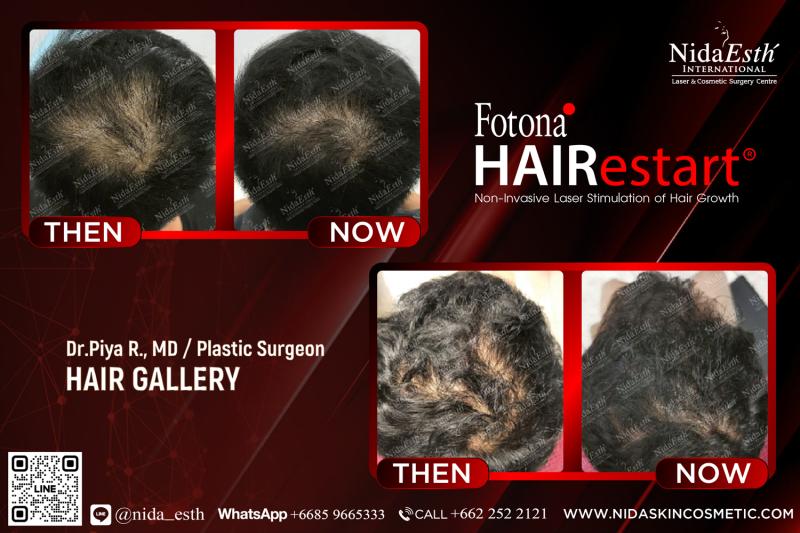
ผู้ที่เหมาะสมสำหรับการรักษา HaiRestart
1. ผู้ที่มีปัญหา AGA (Androgenetic Alopecia)
2. ผู้ที่ไม่ต้องการทานยา และไม่ต้องการผ่าตัด: เหมาะสำหรับผู้ที่ต้องการหลีกเลี่ยงการใช้ยา การผ่าตัด หรือขั้นตอนที่ก่อให้เกิดความเจ็บปวดหรือแผล
3. เหมาะสำหรับผู้ที่เคยผ่าตัดปลูกผมมาก่อน: สำหรับผู้ที่เคยปลูกผมมาแล้ว (เช่น FUE, FUT) แต่ยังมีผมบาง และต้องการเพิ่มความหนาของเส้นผม
4. ผู้ที่มีปัญหาผมร่วงและผมบาง: สำหรับผู้ที่ต้องการผลลัพธ์ที่ดูเป็นธรรมชาติ
1.3 Growth Factor Concept: Hair Vaccine by HARG (Hair Regenerative Therapy)
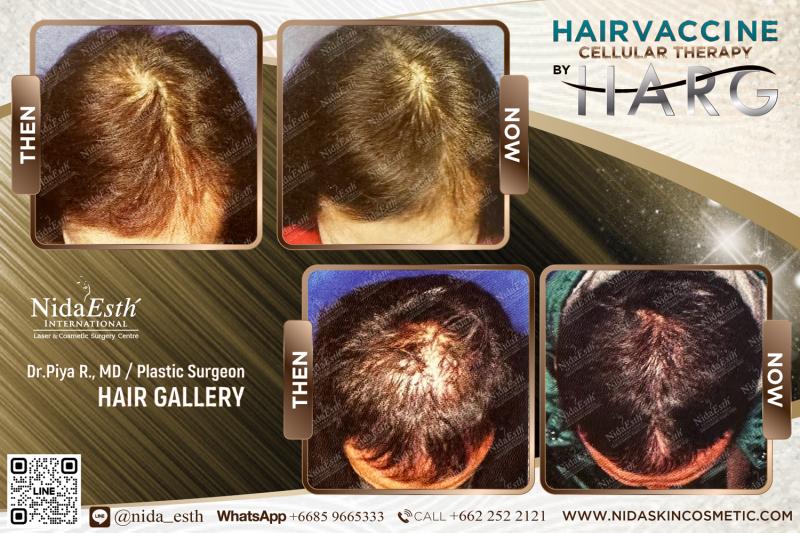
HARG Therapy (Hair Regenerative Therapy) เป็นเทคนิคการฟื้นฟูเส้นผมแบบไม่ผ่าตัดที่ได้รับการจดสิทธิบัตรในประเทศญี่ปุ่น โดยพัฒนาโดย ศ. นพ. Hirotaro Fukuoka ศัลยแพทย์ตกแต่งชื่อดังและอาจารย์ผู้ทรงคุณวุฒิในโรงเรียนแพทย์ชั้นนำในโตเกียว
หลักการทำงานของ HARG Therapy
- การใช้ Growth Factors จาก Adipose-derived Stem Cells
- Growth Factors เป็นโปรตีนที่มีบทบาทสำคัญในการส่งสัญญาณระดับเซลล์ ช่วยกระตุ้นการเจริญเติบโตของเซลล์ การแบ่งตัว และการพัฒนาเซลล์
- การปรับแต่งสูตรเฉพาะบุคคล
- สูตร Growth Factors ที่ใช้ใน HARG Therapy สามารถปรับแต่งให้เหมาะสมกับลักษณะการสูญเสียเส้นผมเฉพาะของแต่ละบุคคล
- เทคนิค Microinjection ที่มีการรุกล้ำน้อย
- การฉีด Growth Factors โดยใช้เทคนิค Microinjection ที่เจ็บปวดน้อยและเป็นที่ยอมรับได้ดีจากคนไข้
ผลลัพธ์และข้อดีของ HARG Therapy
- เพิ่มความหนาแน่นและความหนาของเส้นผม: ผลลัพธ์ที่มองเห็นได้ชัดเจนภายในไม่กี่เดือน
- ปรับปรุงปัญหาผมบางอย่างตรงจุด: สูตรเฉพาะช่วยจัดการกับรูปแบบผมร่วงของแต่ละบุคคล
- ไม่ต้องผ่าตัดและไม่มีผลข้างเคียงจากยา: การรักษานี้ไม่เกี่ยวข้องกับการใช้ยา จึงเหมาะสำหรับผู้ที่หลีกเลี่ยงการทานยา
- ผสมผสานกับเทคนิคอื่นเพื่อผลลัพธ์ที่ดียิ่งขึ้น: สามารถใช้ร่วมกับ UR Cell Hair Micro Transplant+ หรือ Fotona HAIRestart เพื่อเพิ่มประสิทธิภาพ
2. Here are Good Candidates for Non-surgical Hair Transplants
การปลูกผมแบบไม่ผ่าตัดเป็นทางออกที่มีประสิทธิภาพสำหรับคนหลากหลายกลุ่มที่ประสบปัญหาผมร่วง อย่างไรก็ตาม การทราบว่าใครคือผู้ที่ได้รับประโยชน์สูงสุดจากการรักษาเหล่านี้เป็นสิ่งสำคัญเพื่อให้ได้ผลลัพธ์ที่ดีที่สุด ด้านล่างนี้คือรายละเอียดคุณสมบัติของผู้ที่เหมาะสำหรับการฟื้นฟูเส้นผมด้วยเทคนิคขั้นสูงนี้
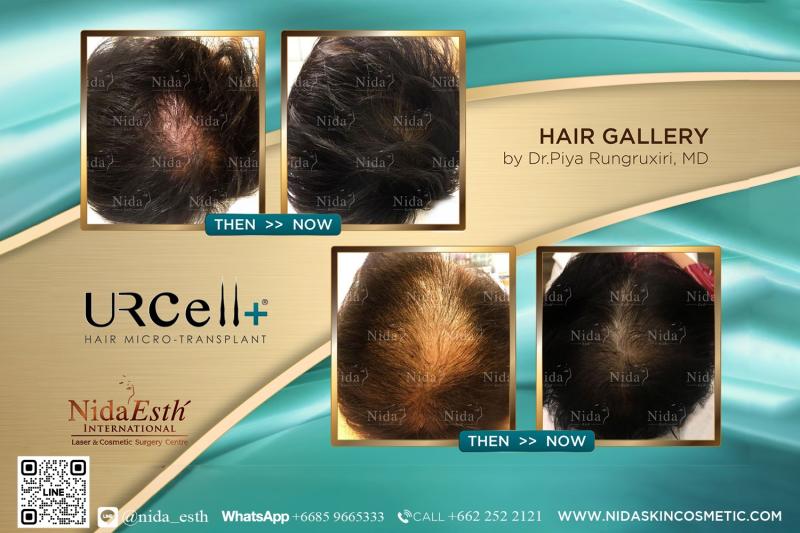
ผมร่วงในระยะแรกถึงปานกลาง
การปลูกผมแบบไม่ผ่าตัดมีประสิทธิภาพเป็นพิเศษสำหรับผู้ที่อยู่ในระยะแรกถึงปานกลางของการสูญเสียเส้นผม คนไข้กลุ่มนี้มักมีลักษณะดังนี้:
1. ผมบางลง
- ผู้ที่เริ่มสังเกตเห็นว่าผมบางลงอย่างค่อยเป็นค่อยไป มากกว่าการหัวล้านโดยสมบูรณ์ เหมาะอย่างยิ่ง รวมถึงผู้ที่มีปัญหาแนวแสกผมที่กว้างขึ้น ปริมาณผมลดลง หรือหนังศีรษะที่มองเห็นได้ชัดเจนยิ่งขึ้น
2. แนวไรผมที่เริ่มบางลง
- ผู้ที่มีแนวไรผมที่ถอยร่น โดยเฉพาะบริเวณขมับและหน้าผาก สามารถเห็นการปรับปรุงได้อย่างมากด้วยการรักษาแบบไม่ผ่าตัด ซึ่งช่วยกระตุ้นการเจริญเติบโตของเส้นผมใหม่ในพื้นที่เฉพาะเหล่านี้
3. การเจริญเติบโตของเส้นผมที่ช้าลง
- ผู้ที่มีปัญหาเส้นผมงอกช้ากว่าปกติเนื่องจากรูขุมขนที่อ่อนแอ สามารถได้รับประโยชน์จากการรักษา เช่น Fotona HAIRestart ซึ่งช่วยฟื้นฟูรูขุมขนและส่งเสริมการเจริญเติบโตของเส้นผมให้เร็วขึ้นและหนาขึ้น
ผู้ที่ไม่ต้องการหรือไม่สามารถเข้ารับการผ่าตัดได้
การปลูกผมแบบไม่ผ่าตัดเป็นตัวเลือกที่ยอดเยี่ยมสำหรับผู้ที่ต้องการหลีกเลี่ยงการผ่าตัดด้วยเหตุผลต่างๆ ดังนี้:
- ความกลัวการผ่าตัด
- หลายคนมีความกังวลเกี่ยวกับความเสี่ยงและความไม่สบายตัวที่อาจเกิดขึ้นจากการผ่าตัด การปลูกผมแบบไม่ผ่าตัด เช่น การใช้เซลล์ต้นกำเนิดหรือ Growth Factors เป็นทางเลือกที่ไม่เจ็บปวด และไม่ต้องมีการกรีดหรือการใช้ยาชา
- ปัญหาสุขภาพที่ไม่เอื้อต่อการผ่าตัด
- คนไข้บางรายมีปัญหาสุขภาพที่ทำให้ไม่เหมาะสำหรับการผ่าตัด เช่น โรคหัวใจและหลอดเลือด เบาหวานที่ควบคุมไม่ได้ หรือโรคที่เกี่ยวข้องกับการแข็งตัวของเลือด
- วิถีชีวิตที่ยุ่งเหยิง
- ผู้ที่ไม่สามารถหยุดกิจกรรมในชีวิตประจำวันได้เนื่องจากภาระงานหรือความรับผิดชอบส่วนตัว มักจะเลือกการปลูกผมแบบไม่ผ่าตัด เพราะมีระยะเวลาพักฟื้นน้อย และไม่มีร่องรอยที่มองเห็นได้หลังการรักษา ทำให้สามารถกลับไปทำกิจกรรมปกติได้ทันที
ผู้ที่ต้องการผลลัพธ์ที่ดูเป็นธรรมชาติ
สำหรับผู้ที่ให้ความสำคัญกับผลลัพธ์ที่ดูเป็นธรรมชาติ การปลูกผมแบบไม่ผ่าตัดเป็นตัวเลือกที่เหมาะสม เนื่องจากการรักษาเหล่านี้ช่วยกระตุ้นและเสริมสร้างเส้นผมที่มีอยู่ของคนไข้ แทนที่จะเพิ่มกราฟต์ผมใหม่ ส่งผลให้เกิดการงอกของเส้นผมที่ดูเป็นธรรมชาติและกลมกลืนกับเส้นผมของคนไข้เดิม
ผลลัพธ์จะปรากฏขึ้นอย่างค่อยเป็นค่อยไปตามระยะเวลา ช่วยหลีกเลี่ยงการเปลี่ยนแปลงที่รวดเร็วเกินไป ซึ่งอาจเกิดขึ้นจากการปลูกผมแบบผ่าตัด การฟื้นฟูแบบนี้ทำให้การเปลี่ยนแปลงดูเป็นธรรมชาติและสอดคล้องกับวงจรการเจริญเติบโตของเส้นผมของคนไข้ ช่วยให้การเปลี่ยนแปลงดูแนบเนียนและไม่เป็นที่สังเกตของผู้อื่น
3. มีการทำงานอย่างไร?
แต่ละเทคนิคการปลูกผมแบบไม่ผ่าตัดมีวิธีการทำงานที่แตกต่างกันดังนี้:
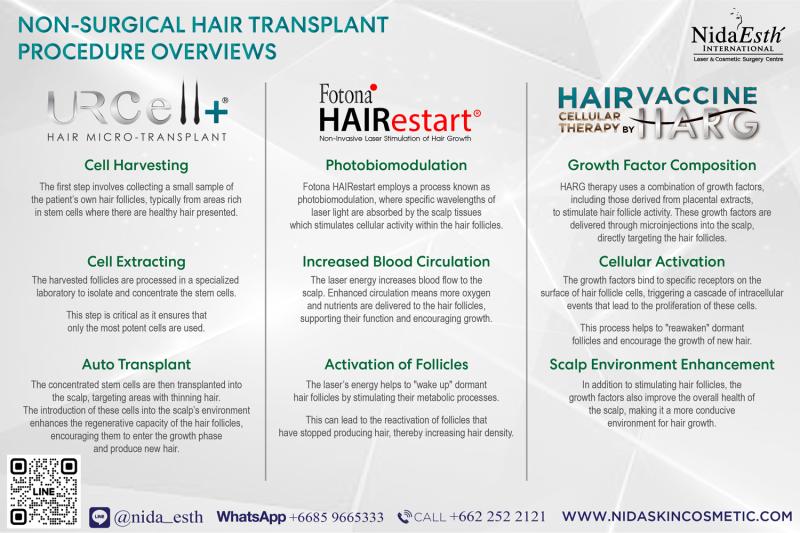
4. ผลลัพธ์ของการปลูกผมแบบไม่ผ่าตัด
การปลูกผมแบบไม่ผ่าตัดได้รับความนิยมเพิ่มขึ้นอย่างมากเนื่องจากสามารถฟื้นฟูเส้นผมได้อย่างมีประสิทธิภาพโดยไม่ต้องพึ่งพาการผ่าตัดที่รุกล้ำ ด้านล่างนี้คือประโยชน์ต่างๆ ที่ทำให้การรักษานี้เป็นทางเลือกที่น่าสนใจสำหรับผู้ที่ประสบปัญหาผมร่วง:
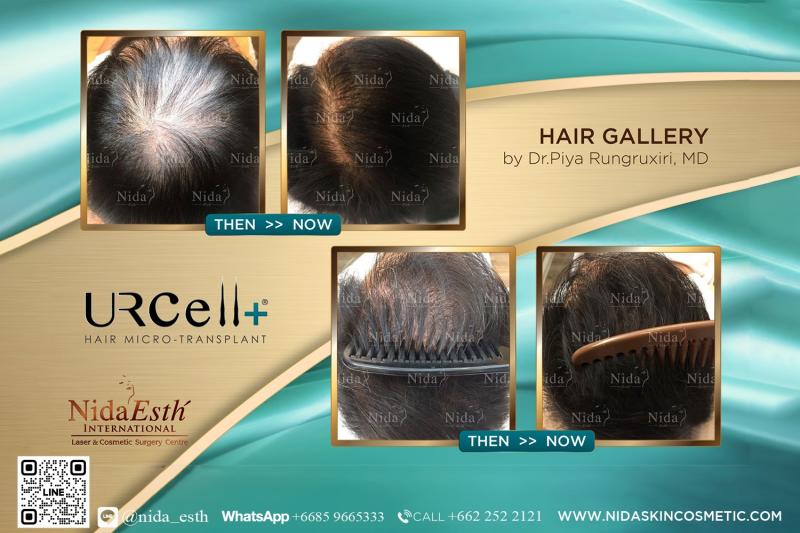
1. การรุกล้ำน้อย (Minimally Invasive)
หนึ่งในข้อดีหลักของการปลูกผมแบบไม่ผ่าตัดคือกระบวนการที่มีการรุกล้ำน้อย ซึ่งหมายถึง:
- ไม่มีการกรีดหรือเย็บแผล: ต่างจากการปลูกผมแบบดั้งเดิมที่ต้องกรีดและปลูกถ่ายรูขุมขน การปลูกผมแบบไม่ผ่าตัด เช่น **UR Cell Hair Micro Transplant+** ใช้เทคโนโลยีเซลล์ต้นกำเนิดขั้นสูงเพื่อกระตุ้นรูขุมขนที่มีอยู่ โดยอาจมีเพียงรอยกรีดเล็กๆ ที่ไม่ต้องเย็บแผล
- ลดความเจ็บปวดและความไม่สบาย:คนไข้รู้สึกเจ็บปวดน้อยมากหรือแทบไม่มีเลยระหว่างการรักษา ซึ่งมักใช้ยาชาเฉพาะที่
- ไม่มีแผลเป็น: เนื่องจากไม่มีการกรีด คนไข้จึงไม่ต้องกังวลเกี่ยวกับรอยแผลเป็นยาวบนหนังศีรษะ เหมาะอย่างยิ่งสำหรับผู้ที่ชอบทรงผมสั้น
- ฟื้นตัวเร็ว: เนื่องจากไม่มีการผ่าตัด คนไข้สามารถกลับไปทำกิจกรรมประจำวันได้เกือบจะทันทีหลังการรักษา โดยไม่ต้องใช้เวลาพักฟื้นยาวนาน
2. ผลลัพธ์ที่ดูเป็นธรรมชาติและค่อยเป็นค่อยไป
ผลลัพธ์ของการรักษาจะปรากฏขึ้นอย่างค่อยเป็นค่อยไป ตามวงจรการเจริญเติบโตของเส้นผม ทำให้ดูสมจริงและกลมกลืนกับเส้นผมเดิม
3. ความเสี่ยงต่อการติดเชื้อลดลง
การไม่มีการกรีดแผลช่วยลดความเสี่ยงของการติดเชื้อ ทำให้การรักษานี้ปลอดภัยยิ่งขึ้น โดยเฉพาะสำหรับคนไข้ที่มีความกังวลเกี่ยวกับกระบวนการฟื้นตัว หรือมีแนวโน้มเกิดภาวะแทรกซ้อนจากการผ่าตัด
4. ไม่ต้องใช้ยาสลบ
กระบวนการรักษาแบบไม่ผ่าตัดมักใช้ยาชาเฉพาะที่หรือยาคลายกังวล ทำให้ไม่ต้องเสี่ยงต่อผลข้างเคียงจากการใช้ยาสลบ เช่น อาการแพ้หรือปัญหาระบบทางเดินหายใจ
5. ควรระวังข้อจำกัดของการปลูกผมแบบไม่ผ่าตัด
แม้ว่าการปลูกผมแบบไม่ผ่าตัดจะมีข้อดีหลากหลาย แต่การเข้าใจถึงข้อจำกัดเป็นสิ่งสำคัญ เพื่อให้ตั้งความคาดหวังอย่างเหมาะสมและพิจารณาว่าการรักษานี้เหมาะกับสภาพปัญหาของคุณหรือไม่
ข้อจำกัดของการปลูกผมแบบไม่ผ่าตัด
1. ไม่เหมาะสำหรับผู้ที่มีปัญหาผมร่วงในระยะรุนแรง
การปลูกผมแบบไม่ผ่าตัดไม่เหมาะสำหรับผู้ที่มีปัญหาผมร่วงในระยะรุนแรง เช่น การหัวล้านที่มีบริเวณกว้างหรือรูขุมขนหยุดทำงานอย่างสมบูรณ์ เนื่องจากการรักษานี้ต้องอาศัยรูขุมขนที่ยังทำงานอยู่หรือทำงานได้บางส่วน ในกรณีที่รูขุมขนหยุดทำงาน การรักษาแบบนี้อาจไม่มีประสิทธิภาพ
2. ต้องใช้เวลานานกว่าจะเห็นผลลัพธ์
ผลลัพธ์ของการรักษามักเริ่มปรากฏหลังจากผ่านไปหลายเดือน เนื่องจากการรักษาต้องพึ่งพาวงจรการเจริญเติบโตของเส้นผมตามธรรมชาติ คนไข้ที่ต้องการผลลัพธ์ที่รวดเร็วอาจรู้สึกว่ากระบวนการนี้ใช้เวลานานเกินไป
3. ต้องเข้ารับการรักษาหลายครั้ง
หนึ่งในข้อจำกัดสำคัญของการปลูกผมแบบไม่ผ่าตัดคือความจำเป็นในการเข้ารับการรักษาหลายครั้ง เพื่อให้ได้ผลลัพธ์ที่ดีที่สุด ต่างจากการปลูกผมแบบผ่าตัดที่สามารถเปลี่ยนแปลงได้ในครั้งเดียว การรักษาแบบไม่ผ่าตัดต้องกระตุ้นการเจริญเติบโตของเส้นผมอย่างค่อยเป็นค่อยไป คนไข้ต้องมีความมุ่งมั่นในการเข้ารับการรักษาเป็นระยะ โดยมักเว้นช่วงเวลาไม่กี่สัปดาห์ต่อครั้ง
4. อาจต้องมีการดูแลรักษาผลลัพธ์ต่อเนื่อง
แม้ว่าจะได้ผลลัพธ์ที่พึงพอใจแล้ว แต่คนไข้ส่วนใหญ่มักต้องเข้ารับการดูแลรักษาเพิ่มเติมเพื่อรักษาผลลัพธ์ที่ได้จากการปลูกผมแบบไม่ผ่าตัด
Non-surgical hair transplants represent a significant advancement in hair restoration technology, offering effective solutions for those looking to combat hair loss without the need for surgery. By focusing on stem cells, laser therapy, and growth factors, these treatments provide a natural, minimally invasive way to achieve fuller, healthier hair.
As a plastic surgeon, I have seen how these techniques can transform lives, restoring not just hair, but also confidence and self-esteem. If you are considering hair restoration, these non-surgical options are well worth exploring, providing a sophisticated alternative to traditional methods.
Author:
- Dr. Piya Rungruxsiri, MD, or Dr. Piya at Nida Esth' International
- Best Plastic Surgeons in Thailand
- A Board-certified Plastic Surgeon from General Surgery from Thai Medical Council & the International Society of Aesthetic Plastic Surgery (ISAP)
Membership:
- Member of Thai Society of Plastic and Reconstructive Surgeons of Thailand
- Member of Thai Society of Aesthetic Plastic Surgeons of Thailand
Education:
- Doctor of Medicine, Chulalongkorn University
- Board of General Surgery, Chulalongkorn University Hospital
- Board of Plastic & Reconstructive Surgery, Chulalongkorn University Hospital
Affiliated Hospitals


